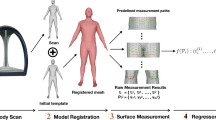Abstract
This paper presents the development of an automated anthropometric data-collection system for digital human models obtained from a three-dimensional whole-body scanner. Thirty-seven landmarks were specified for feature recognition and data collection. Both color information and geometric relations were used to develop the algorithms for identifying the landmarks. The proposed landmark identification method has been tested on 105 human models. The recognition rate was over 98%. The experimental results indicate that the proposed method was very efficient and effective in identifying the landmarks. Furthermore, 103 anthropometric dimensions can be extracted from a digital human model. Comparing the data obtained from the proposed system with those obtained by the traditional direct measurement method, the system is fast, accurate, and consistent. Moreover, based on the collected body dimensions, clothing patterns can be directly generated in CAD file format, and textile cutting can be subsequently executed by a CNC laser cuter. An automated tailoring system can thus be developed. The concept of mass customization for the apparel industry can thus be realized.
Similar content being viewed by others
References
Robinette KM, Daanen H, Paquet E (1999) The Caesar project: a 3-D surface anthropometry survey, Proceedings of the 2nd International Conference on 3-D Digital Imaging and Modeling, October 1999, Ottawa, Canada, pp 380–386
Treleaven P (2004) Sizing us up, IEEE Spectrum 41(4):28–31
Brunsman MA, Daanen HM, Robinette KM (2000) Optimal postures and positioning for human body scanning, Proceedings of International Conference on 3-D Digital Imaging and Modeling, October 1999, Ottawa, Canada, pp 226–273
Daanen HAM, Brunsman MA, Robinette KM (1997) Reducing movement artifacts in whole body scanning, Proceedings of International Conference on Recent Advances in 3-D Digital Imaging and Modeling. IEEE Computer Society Press, Los Alamitos, CA, pp. 262–265
Douros I, Buxton B, Treleaven P (2000) Developing techniques for building active shape models from 3D Scanner data for the representation of human bodies, PhD Thesis, University College of London, London
Buxton B, Dekker L, Douros I, Vassilev T (2000) Reconstruction and Interpretation of 3D Whole Body Surface Images, Scanning 2000 Proceedings, Paris, France
Pargas RP (1998) Automating information extraction from 3D scan data, DLA-ARN T2p5 Project Report, Clemson University, Clemson, SC, USA
Daanen HAM, Water GJ (1998) Whole body scanners. Displays 19:111–120
Author information
Authors and Affiliations
Corresponding author
Rights and permissions
About this article
Cite this article
Wang, MJ.J., Wu, WY., Lin, KC. et al. Automated anthropometric data collection from three-dimensional digital human models. Int J Adv Manuf Technol 32, 109–115 (2007). https://doi.org/10.1007/s00170-005-0307-3
Received:
Accepted:
Published:
Issue Date:
DOI: https://doi.org/10.1007/s00170-005-0307-3




